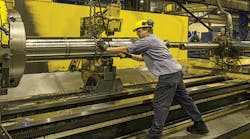“Forging a Culture of Safety Excellence" is not an easy thing to do in a high-hazard industries like foundries and forging, John P. McGillivray, manager of safety and environmental for Scot Forge Inc., explained to attendees at the 2016 Safety Leadership Conference in Pittsburgh.
In 1997, “We sent 107 people to the clinic/hospital out of a total shop population of 375 people,” he acknowledged. The company’s TIR rate was 25. The DART rate was 7.5. The company spent $1 million in workers’ compensation expenses.
Looking back at 1997’s safety performance, McGillivray examined some of the factors that existed at the time:
- The culture placed getting product out the door above all else. “What” was accomplished was emphasized more than “how” it was accomplished.
- The company and industry had an old-school mentality about safety.
- History “regularly” repeated itself.
- There was no engagement of the workforce.
- There were limited pro-active safety activities.
“When I arrived at Scot Forge, the safety manual was ‘borrowed’ from another local company. Everywhere the original company’s name appeared, it was meticulously crossed out and ‘Scot Forge’ was written above it,” McGillivray remembered.
What did the $1 million in workers’ compensation payments earn the company? “This letter from OSHA saying, ‘Scot Forge, you suck,’” said McGillivray. The company was placed on OSHA’s primary inspection list for a comprehensive safety and health inspection.
What McGillivray realized, and needed to reinforce to leadership, was that “it’s not the Code of Federal Suggestions. You are required [to comply with] the requirements of OSHA standards.” But being in full compliance is not enough to stop employees from getting hurt. Compliance is “not a destination; it’s a starting point,” he added.
“Compliance officers will tell you that less than 10 percent of the injuries on the OSHA 300 log are the result of a missing OSHA program. I was thinking to myself, ‘What are we doing the other 90 percent of the time?’ We were our own worst enemy,” said McGillivray.
He realized it was time to start over at Scot Forge and build a new culture. The purpose of the safety process wasn’t just to manage compliance but to manage performance by protecting employees and being good steward of the company’s resources.
McGillivray defined culture as the beliefs, expectations and practices that make up “the way we do things around here.” Culture, which he noted plays a huge factor in safety performance, is created by management’s beliefs put into action. Employees take their cues from management:
- The expectations management sets
- Their decisions and actions
- Communications
- Engagement/involvement
- Willingness to accept and act upon input
- Recognition of accomplishments (what and how).
While the company adopted several new programs and processes, the one that had the most impact in McGillivray’s opinion was situational awareness training. He offered this example for educating employees about situational awareness:
Look at the cuts, scars, bruises on your arms and hands.
- What percentage was caused by a missing OSHA program?
- What percentage was caused by an equipment malfunction?
- What percentage was caused by someone else injuring you?
- What percentage was caused by something within your control or preventable with a little better pre-planning?
The company implemented the SafeStart program in August 2010, and it teaches four techniques to overcome issues that contribute to injuries such as rushing, frustration, fatigue or complacency. Employees conduct pre-task assessments that encourage them to stop and take a moment to really concentrate on the tasks ahead of them.
Not only have injuries shown a substantial decrease as a result of improving the safety culture, but quality has improved. Said McGillivray. “We dramatically reduced our quality issues while simultaneously reducing our injuries. A quality error is thought of like an injury to a customer.”

